This Moroccan-Israeli Matbucha recipe is a delicious vegan tomato and pepper salad that’s easy to make.
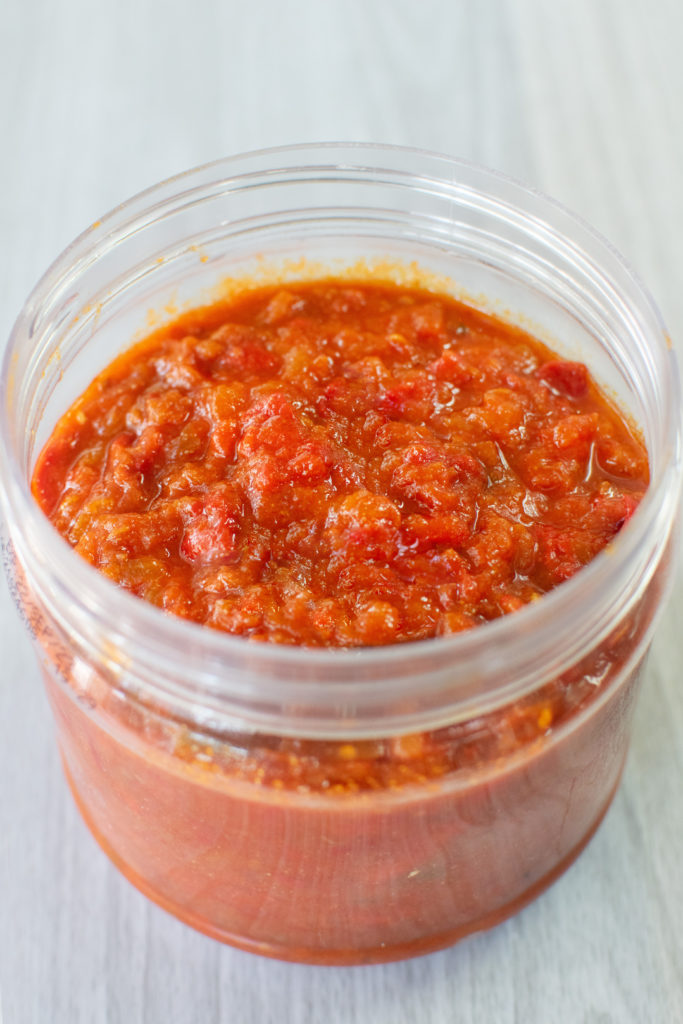
This Moroccan-Israeli Matbucha recipe is an easy-to-make (the longest part is the cooking) salad that is normally eaten in pita, alone or with another filler.
However, you can use it any way you like (my daughter likes to mix it in with plain pasta). In the US, you can find matbucha in Israeli markets and even in delis in Jewish areas.
Some people make matbucha with quite a bit of oil, but I like to minimize oil and use as little as possible, so the recipe includes a measurement range of 1/ 3 – 1/2 cup.
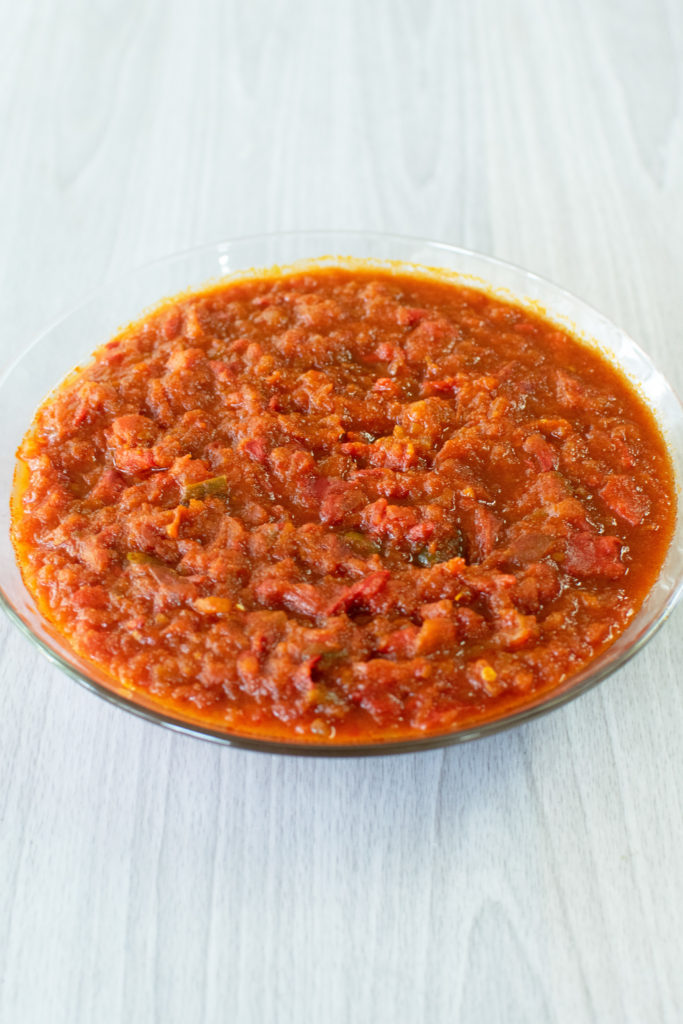
In addition to the fact that Moroccan-Israeli Matbucha is delicious, it has health benefits in the tomatoes, red peppers, and jalapeño peppers!
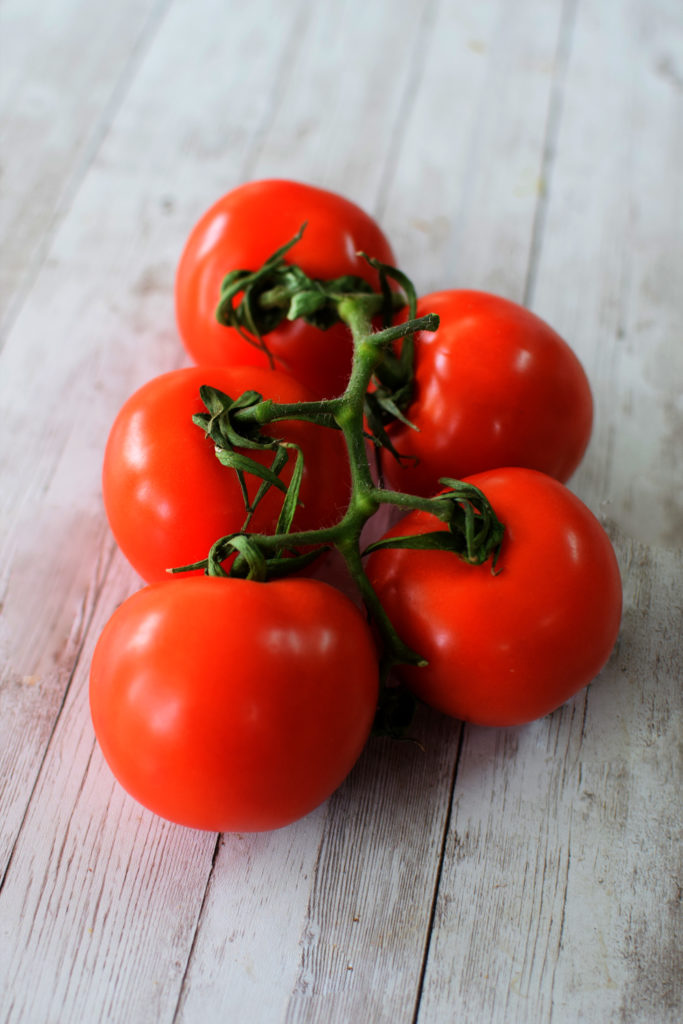
A little of my cooking background
I really wanted to title this blog “If I can make it, anyone can” because, honestly, if I can make it, anyone can.
I never really liked cooking, and when I was single, a meal for me meant grilled cheese, eggs, tuna, or something else that didn’t require effort or time.
When my kids were young, I was still able to get away with preparing only a small variety of easy meals, but the older they got, the more dishes I learned to make at their request.
Still, I insisted on keeping it simple.
Honestly, I never understood why some cooks unnecessarily complicate meals. I have seen recipes that have several ingredients that don’t really seem to add much, if anything, to the dish. So, why bother?
It has always been important to me that whoever eats at my table will have plenty to enjoy, and that includes my kids (I never agreed with the “You will eat what is served, or you won’t eat” ideology), and, because I keep it simple, I can prepare a variety of dishes in a relatively short period of time.
I have a philosophy regarding being a great cook: Prepare food according to the tastes of those who will be eating it, and they will love your cooking!
As far as I am concerned, start with the basic ingredients that make the dish what it is, adapt according to taste, and voila! You are an amazing cook!
The bottom line is that while there are certainly delicate recipes out there for specialty dishes, making delicious meals doesn’t have to be complicated or time-consuming. It’s not difficult to impress—just make sure it tastes good.
While some of the recipes on my blog are more time-consuming than others, they are all tried and true, easy-shmeezy!
Of course, one always has to consider the conditions under which they cook. Weather (humidity, heat, cold), different types of ovens, different qualities of pots, etc.—all of which can affect your cooking and baking.
Nevertheless, as I said, if I can do it, anyone can!
Everyday pantry essentials (suggested)
As I learned to prepare more and more recipes, I also learned which basics and seasonings are good to have on hand to have the ability to make a dish on short notice and not have to run out to the store or borrow from a neighbor.
While I will admit that I am not always prepared when one of my kids asks for eggplant parmesan or lasagna at the drop of a hat (which they have done), I dislike having to postpone making something just because the ingredients needed to make a reasonable meal were not readily available.
So, I maintain a selection of what I consider “pantry essentials” in my refrigerator and on my shelves at all times.
Initially, many of the herbs and spices were useful to me only on occasion (having been purchased for a particular recipe), and I usually just had them around as leftovers. However, as I began to cook more of a variety, I was really glad to have them (hey, look, I already have that!). And that is how my list began.
While, of course, most of the essentials will not be needed just for any one recipe, at least some of them are needed for most recipes, and you would be surprised how many recipes can be made just with this list. So, if you keep whatever you use regularly on hand, it can really save you time and effort.
Everyone has their favorite recipes, preferred seasonings, and just whatever they like to use to cook. Your own list should certainly reflect your own cooking tastes and style.
Just to give you an idea, the list below is a comprehensive list of what I normally keep on hand (this does not necessarily include what I keep for baking, and there may be some overlap between the two lists as some items are used for both, such as brown sugar), and, of course, it reflects the meals and desserts that I like to make for my own family and guests.
Utensils:
- Measuring cups for liquid
- Measuring cups for solids (flour, sugar, etc.)
- Measuring spoons
- Mixing bowls
- Kitchen scale
NOTE: When using measuring cups and spoons, make sure that the measurements are comparable to one another (example: that 4 tablespoons equals 1/4 of your measuring cup). You’d be surprised to know that not all measuring cups are the same, and this can throw your measurements off.
Seasoning and flavoring:
- salt (my recipes use regular table salt)
- ground black or white pepper
- granulated garlic or garlic powder (I prefer granulated)
- onion powder
- sweet paprika and/or sweet pepper flakes (paprika is ground dried red pepper, pepper flakes are crushed dried red pepper)
- hot paprika, hot pepper flakes, or cayenne pepper (moderately spicy dried ground chili pepper) for those occasional spicy dishes
- ground turmeric
- ground cumin
- ground cinnamon
- ground ginger
- ground nutmeg
- ground cloves (for pumpkin flavors)
- sugar (granulated)
- brown sugar
- chicken consommé powder / beef bouillon powder (regular or vegetarian)
- onion soup mix
- onion flakes (substitute for fresh onion—3 tablespoons for 1 medium onion).
- various herbs
- additional spices to adapt taste to preference
Misc:
- oil / margarine / butter / cooking spray
- coconut cream as a dairy-free cream substitute
- flavorless milk substitute as a dairy-free milk alternative
- cornstarch as a thickening agent
- flour
- baking powder
- baking soda
- bread crumbs or cornflake crumbs (you can make these with your blender or food processor) for coating
- condiments, such as ketchup, mustard, barbecue sauce
- tomato sauce/tomato paste/canned tomatoes—diced or crushed/pasta sauce
- soy sauce
- ready-made pie crusts and dough (to just add filling)
We always have eggs in the fridge and onions, rice, and potatoes on our shelves, as well as pasta.
In addition, having some fresh vegetables in the fridge, such as carrots, celery, tomatoes, bell peppers (various colors), etc., can be very useful when putting together a quick but delicious meal.
It is also a good idea to have some ground meat or chicken (breast, ground, or in parts) in the freezer for anyone who likes meat dishes in a snap.
Weather can have an effect on some of the spices and on the chicken consommé powder, so I keep as many of the seasonings in the refrigerator or freezer as I can, and I keep everything tightly closed in containers (you will be surprised to know just how determined moths are at getting into sealed bags and how hot red pepper powder can attract little black bugs—YUCK!).
Therefore, store your items well.
Why are these pantry essentials beneficial to have on hand?
Personally, having the above ingredients in my kitchen is very advantageous, as I make a variety of dishes and use most of the items on the list regularly enough to warrant storing them. However, I do not store items for dishes that I make seasonally or only on rare occasions or those that spoil easily.
Whether or not it is workable for you depends on your cooking style, the space you have to store, and whether or not you mind running out to the store as needed. Of course, the more you cook and the more varied your recipes, the more you will use and the more you will need.
A little information about bell peppers
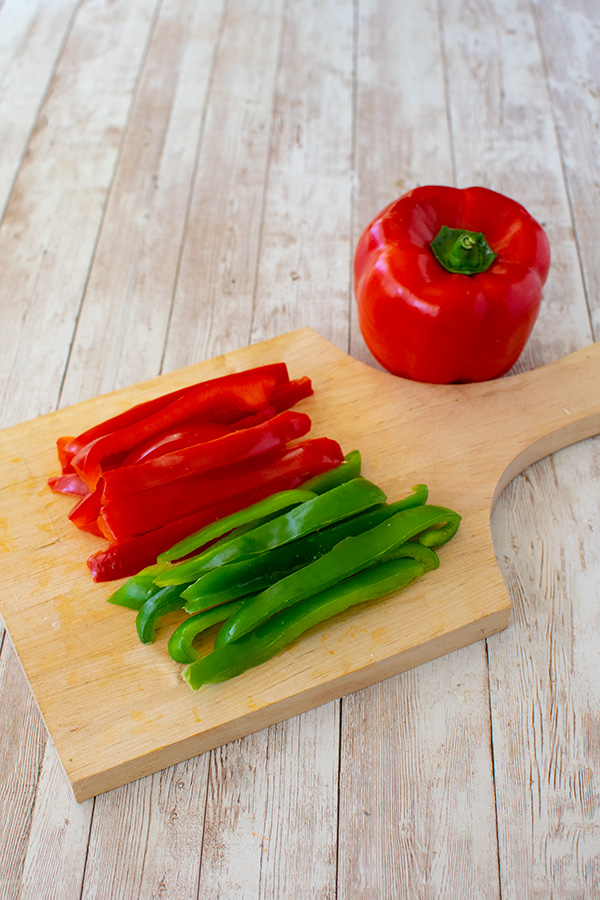
Bell peppers come in different colors, such as green, red, orange, yellow (the most common)…and, believe it or not, white brown, striped, and purple.
Peppers are commonly used in foods, salads, as side dishes, toppings or – if you are like my son – a snack.
Peppers are native to Mexico, Central America, and South America. Spanish explorers brought pepper seeds back to Spain with them in 1943. From Spain, peppers spread from there to Europe and Asia.
Red peppers are actually ripened green peppers and because they do so gradually, you may see peppers that are both green and red at the same time. Red peppers sweeter in flavor than the green, which are more acidic and a little bitter. Red peppers can be used in the production of paprika.
“Permagreen” don’t turn red, but rather stay green even after they ripen.
Orange and Yellow peppers are their own varieties and have a gentle, sweet taste.
Bell peppers contain almost no protein at all and are almost entirely made of water, with a small percentage of carbohydrates. They are rich in vitamins C, B6, K, A, and E as well as some minerals and antioxidants. The different colored peppers contain different vitamins and nutrients, and they are all very low in fat.
Bell peppers generally have a long life, especially if kept in refrigeration.
Moroccan Jews in Israel
The majority of Moroccan Jews in Israel are the descendants of Jews that immigrated to Israel from Morocco.
Before the establishment of the State of Israel, the British put a quota on the amount of Jews that could immigrate to Israel, so most of the immigration was considered “illegal.” However, many Jews risked their lives to flee their countries of origin, including Arab and Muslim countries, such as Morocco.
Because the Muslims were against the establishment of the State of Israel, after the declaration of the state and the civil war that followed, life became more difficult for the Jews of Morocco, because the Muslims would attack Jews as a result. This brought about a wave of immigrants to Israel from Morocco, as did every Arab-Israeli war that followed.
So, during the 1950s and for decades afterward, waves of Moroccan Jews immigrated to Israel.
Morocco was once the home of the largest Jewish community in the Muslim world. However, by the time of the Yom Kippur war, the majority of Morocco’s Jews had immigrated to Israel, and they brought their delicious cuisine with them.
A little about Israeli cuisine
Some people complain about cultural appropriation in cuisine when food from one country is attributed to another country.
However, national cuisine in itself is often a mingling of food from a variety of cultures, often due to a change of ruling countries and a shifting of borders.
Turkish cuisine, for example, goes back to the Ottoman Empire and was a combination of several cultures under Ottoman rule.
When people move from country to country, they will take their cultures with them, and their descendants may adapt their traditional cuisine with that of their new home, and if they don’t, others might.
Chinese food in US restaurants is quite often not really authentic Chinese but American Chinese.
Americans have created a whole variety of types and styles of pizza, and pineapple pizza was apparently created in Canada by a Greek immigrant. Yet, everyone still calls them all “pizza,” which originated in Italy.
Spaghetti is thought to be an Italian food, but many historians believe that it was brought back to Italy from China by Marco Polo.
Apparently, battered fried fish was from the Portuguese Jewish community as a Sabbath food and ended up in England via Holland during the Spanish Inquisition, yet everyone attributes the food to the British.
…and don’t get me started on Hummus.
When one lives in a melting pot, such as the US or Israel, it is just unrealistic to expect that food from a particular culture won’t mingle with that of other cultures.
That being said, “Israeli cuisine” is basically Middle Eastern (as opposed to Eastern European food) that was brought to Israel by Jews when they fled or were expelled from Muslim countries and moved to Israel mostly after the declaration of the State of Israel (collectively known as Mizrahi Jews).
Recipes were passed from generation to generation, and although decades have passed, the foods are still known by the culture they came from, and everyone seems to have their own way of making them.
That said, there are many variations of pretty much any “Israeli” recipe because of background, custom, or even just taste. When choosing a recipe, one has to know what actually constitutes a main ingredient – what makes the dish what it is – and what is left up to individual taste.
I personally find it very arrogant and quite irritating when a blogger (not naming names) will put “authentic” in the title of an “Israeli” recipe, as if all the rest of the variations are mere imitations. What’s worse is when that blogger makes the recipe with her own twist and then calls it authentic!
Adding more or less of a spice or adding a spice that is not in the recipe does not make it less authentic, but calling it “authentic” and then adding unnecessary extra ingredients above and beyond what needs to be there is misleading.
For example, “authentic” Israeli salad (what Israelis call Israeli salad) is diced tomatoes and cucumbers. Sometimes, they will add some oil, salt, and pepper, but THAT’S IT. Anything else does not have to be there, but if you leave out the cucumbers or the tomatoes, you no longer have an “Israeli salad.”
So, find the recipes you like with the ingredients you prefer, add your own twists, and בתאבון (literally translated, “with appetite”)!
Like Moroccan Israeli food? Try: Moroccan-Israeli Style Salmon, Easy Moroccan-Israel Meatballs with Olives, and Morccan-Israeli Fish
Matbucha Recipe
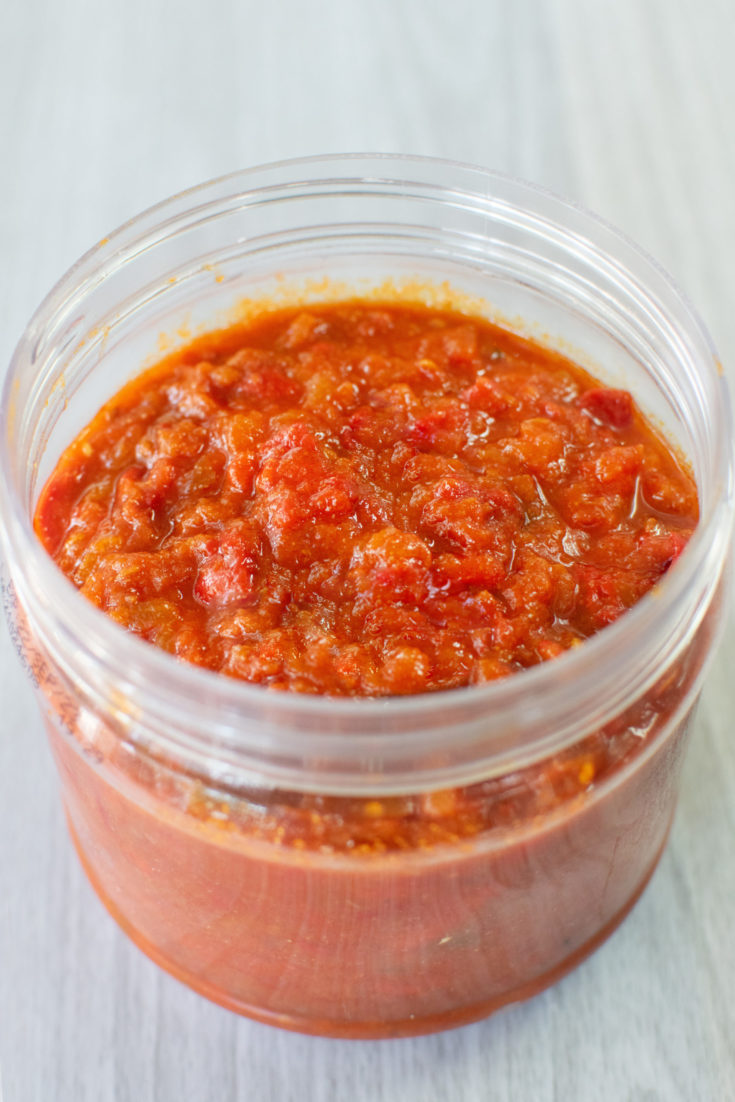
Moroccan tomato and pepper salad. Vegan and gluten free.
Ingredients
- 2 - 28 ounces of peeled tomatoes, diced small
- 2 red peppers, diced small
- 2 medium jalapeno peppers, diced small
- 2 tablespoons paprika, per taste
- 1 tablespoon sugar
- 1 1/2 tablespoons granulated garlic
- 2 teaspoons salt
- 1 teaspoon cumin, optional
- 1 teaspoon chili pepper flakes, optional (if you want spicy)
- 1/3 - 1/2 cup oil
- 2/3 cup water
Instructions
- Cover the bottom of a large sauce pan or skillet with the oil.
- Lightly fry the diced red peppers and jalapeno pepper on medium heat.
- Mix in the paprika, sugar, garlic, cumin, salt, and chili pepper flakes if desired.
- Add tomatoes and water.
- Cook on medium low for 1/2 - 1 hour, while mixing occasionally so that the mixture does not stick to the bottom (add more water, a little at a time, if needed) and mashing occasionally with a fork or potato masher, until the liquid has mostly evaporated and you are left with a thick sauce.
- Let cool.
Nutrition Information:
Yield:
12Serving Size:
1Amount Per Serving: Calories: 69Total Fat: 4gSaturated Fat: 0gTrans Fat: 0gUnsaturated Fat: 3gCholesterol: 0mgSodium: 362mgCarbohydrates: 9gFiber: 2gSugar: 6gProtein: 2g